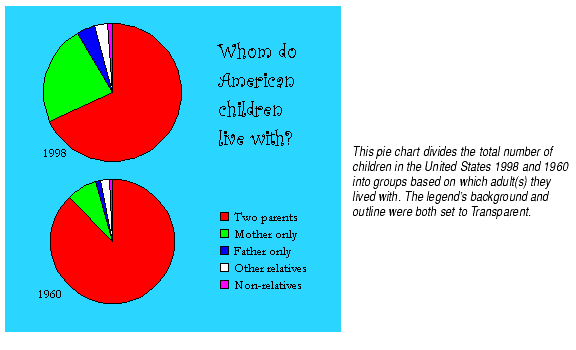
Pie charts show each cell's data as a slice of a pie. The chart may contain one or more pies. Pie charts show the relationship of parts to the whole.

Each pie shows a series of data; slices of the same color belong to the same category. Note that this is the opposite of the way Formula One for Java interprets series and category data on most charts. This means that pie chart legends show category labels, not series labels.
Formula One for Java displays the pie slices clockwise in the same order as they appear in the chart's data source.
By default, the size of the pies is determined by the total value of the data points in each pie. All data points in each pie are summed; the pie with the largest total is the largest pie, with the remaining pies sized proportionally smaller.
If you don't want to display the pies sized proportionally, you may choose to display all the pies the same size.
To change the sizes of the pies:
Formula One for Java displays the pie slices clockwise in the same order as they appear in the chart's data source. By default, the edge of the first slice starts at 0°, or the 12 o'clock position. You can change the position of that starting edge. All pies on the chart must have the same starting position.
The start angle is expressed in degrees, where 180° is the 6 o'clock position.

To change the start angle of the pies' slices:
You may display the pie slices adjacent to one another, as shown in the previous examples, or you may display the pie as if cut into pieces, with its slices pulled apart. This is called exploding the slices. You may do this for one or all of the pies on the chart.

As you can see in these examples, exploded pie slices are smaller than unexploded slices. They shink because the pie's outside circumference must remain the same size to ensure that it fits on the chart plot.
You cannot pull out just one pie slice.
To explode the pie slices:
Changing the order of the pies. Since each pie represents a series, you can change the order of the pies by changing the order of the series. For information, see Changing the Order of Chart Series.
Labeling pies. While Formula One for Java has no automatic option for labeling each pie, you can create a data label for a pie slice, edit it to display the name you want, then drag it to a new position next the pie. You should try to make it clear that the label applies to the entire pie. For more information, see About Data Labels.
The Vary Colors option. On the Options tab of the Plot dialog, the Vary Colors option is automatically selected for pie charts. This makes each slice of the pies a different color. If you uncheck the Vary Colors checkbox, each pie will appear as a different solid color, with the slices delineated by lines. For more information, see Automatically Varying Data Point Colors.
